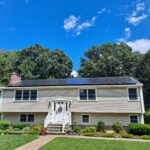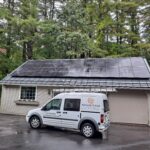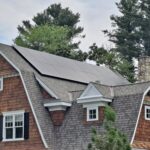We got our first real snowfall in Boston so I thought today’s post would be fitting. Many people think that investing in solar power in New England is ludicrous. Here in Massachusetts, we live in a climate that is prone to cold temperatures and unpredictable weather conditions, including ice and snow, for about a third of the year. How can solar panels produce power when it looks gray outside most of the day or when they are covered with snow?
Did you know that cold temperatures are actually good for generating solar power? The record hot spell last summer wasn’t doing your solar photovoltaic (PV) system any favors. You would think hot temperatures mean a lot of sunny weather and this would be great for solar panels. Sun is a photovoltaic panel’s best friend; but, high temperatures can be their worst enemy.
So exactly what do higher temperatures do to solar photovoltaic panels? As temperatures rise, the efficiency of solar panels decreases. Heat causes electrical resistance to the flow of electrons. On days where the temperature is more than 75 degrees, the electrical resistance makes the voltage fall thereby producing less kilowatts per hour. Your roof is hotter than temperatures on the ground. That’s why solar panels are not mounted flat to a roof. There is usually a few inches of spaces between the panels and roof so air flow can pass easily through and cool the panels down.
We’ve answered the question about cold weather, but how does cloudy weather play into production? Let’s look at a good example. Germany has the largest installed solar capacity in the world and New England has more sun hours than Germany does in an average day. Our available sun power here in New England is about 80% of the sunniest parts of the Southwestern US and is much greater than anywhere in Germany. Germany is actually about as sunny as Alaska! In addition, PV systems still produce energy on cloudy days. The electricity production may not be as high as on a sunny day, but your system will still produce electricity because there will still be some irradiance. Under a light overcast day, panels might generate about half as much power as under full sun.
The economic viability of solar power is actually a function of available sun and local incentives. Some states with a tremendous amount of sunny days do not incentivize their citizens financially to invest in solar power. Massachusetts are among the 5 or 6 most “solar-friendly” states in terms of economic incentives in the form of rebates, tax credits and exemptions, Solar Renewable Energy Credits (SRECs) and net metering policies.
The last big question you probably have about solar power in the winter is concerning snow. A lot of homeowners are worried about the production of their solar installation after snowfall. When it snows, the snow may cover the solar panels and affect the production of your system. However, in most cases enough sunlight will still be able to penetrate through to the modules, warming them and melting the layer of snow that is on them. Snow typically clears from your solar panels much sooner than other parts of the roof. In situations where you do have safe access to the roof, you can clear off snow from your PV system using a specialized tool called a roofrake. Be sure you purchase a roofrake that will not scratch the solar panels.
There is no cure for shorter daylight hours in the winter, but don’t expect solar power production to drop off entirely. Brightstar Solar is a Massachusetts solar installer and can help you navigate how to best take advantage of the local, state, and federal incentives that are available. To learn if solar is right for your Massachusetts home, our company offers a complimentary solar assessment where we can predict what production will look like for every month of the year. Please contact us at 617-564-0050 to schedule an appointment.








Pingback: Cold Weather, Snow, and Solar Power in New England — BRIGHTSTAR SOLAR
Pingback: Tweets that mention Cold Weather, Snow, and Solar Power in New England — BRIGHTSTAR SOLAR -- Topsy.com